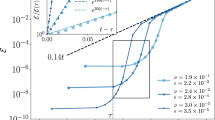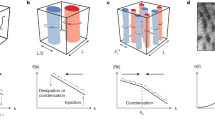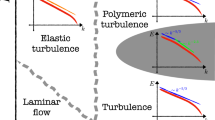Abstract
Chaotic advection1,2,3 of a fluid can cause an initially inhomogeneous impurity (a passive scalar field) to develop complex spatial structure as the elements of the fluid are stretched and folded, even if the velocity field is periodic in time. The effect of chaotic advection on the transient mixing of impurities—the approach to homogeneity—has been explored theoretically and numerically4,5,6,7,8. A particularly intriguing prediction is the development of persistent spatial patterns, whose amplitude (contrast) decays slowly with time but without change of form. Here we investigate these phenomena using an electromagnetically driven two-dimensional fluid layer in which one half is initially labelled by a fluorescent dye (the passive scalar). We observe the formation of structurally invariant but slowly decaying mixing patterns, and we show how the various statistical properties that characterize the dye concentration field evolve with time as mixing proceeds through many cycles. These results show quantitatively how advective stretching of the fluid elements and molecular diffusion work together to produce mixing of the impurity. We contrast the behaviour of time-period; c flows and identically forced but weakly turbulent flows at lower viscosity, where mixing is much more efficient.
This is a preview of subscription content, access via your institution
Access options
Subscribe to this journal
Receive 51 print issues and online access
$199.00 per year
only $3.90 per issue
Buy this article
- Purchase on Springer Link
- Instant access to full article PDF
Prices may be subject to local taxes which are calculated during checkout





Similar content being viewed by others
References
Aref,H. Stirring by chaotic advection. J. Fluid Mech. 143, 1–21 (1984).
Ottino,J. M. Mixing, chaotic advection, and turbulence. Annu. Rev. Fluid Mech. 22, 207–253 (1990).
Fountain,G. O., Khakhar,D. V. & Ottino,J. M. Visualization of three-dimensional chaos. Science 281, 683–686 (1998).
Pierrehumbert,R. T. Tracer microstructure in the large-eddy dominated regime. Chaos Solitons Fractals 4, 1091–1110 (1994).
Antonsen,T. M., Fan,Z., Ott,E. & Garcia-Lopez,E. The role of chaotic orbits in the determination of power spectra of passive scalars. Phys. Fluids 8, 3094–3104 (1996).
Antonsen,T. M. & Ott,E. Multifractal power spectra of passive scalars convected by chaotic fluid flows. Phys. Rev. A 44, 851–857 (1991).
Muzzio,F. J., Meneveau,C., Swanson,P. D. & Ottino,J. M. Scaling and multifractal properties of mixing in chaotic flows. Phys. Fluids A 4, 1439–1456 (1992).
Alvarez,M. M., Muzzio,F. J., Cerbelli,S., Adrover,A. & Giona,M. Self-similar spatiotemporal structure of intermaterial boundaries in chaotic flows. Phys. Rev. Lett. 81, 3395–3398 (1998).
Paret,J., Marteau,D., Paireau,O. & Tabeling,P. Are flows electromagnetically forced in thin stratified layers two-dimensional? Phys. Fluids 9, 3102–3104 (1997).
Williams,B. S., Marteau,D. & Gollub,J. P. Mixing of a passive scalar in two-dimensional turbulence. Phys. Fluids 9, 2061–2080 (1997).
Paret,J. & Tabeling,P. Experimental observation of the two-dimensional inverse energy cascade. Phys. Rev. Lett. 79, 4162–4165 (1997).
Miller,P. L. & Dimotakis,P. E. Reynolds number dependence of scalar fluctuations in a high Schmidt number turbulent jet. Phys. Fluids A 3, 1156–1163 (1991).
Shraiman,B. I. & Siggia,E. D. Lagrangian path integrals and fluctuations in random flow. Phys. Rev. E 49, 2912–2927 (1994).
Acknowledgements
We thank J. Andersen, J.-C. Geminard, A. Kudrolli, and W. Losert for experimental contributions, and E. Ott and B. Shraiman for discussions. This work was supported by the Condensed Matter Physics Program of the US NSF.
Author information
Authors and Affiliations
Corresponding author
Rights and permissions
About this article
Cite this article
Rothstein, D., Henry, E. & Gollub, J. Persistent patterns in transient chaotic fluid mixing. Nature 401, 770–772 (1999). https://doi.org/10.1038/44529
Received:
Accepted:
Issue Date:
DOI: https://doi.org/10.1038/44529
This article is cited by
-
Fluid mixing optimization with reinforcement learning
Scientific Reports (2022)
-
Chaotic Flow Patterns from a Deep Plutonic Environment: a Case Study on Natural Magma Mixing
Pure and Applied Geophysics (2015)
-
Mass transfer enhancement and surface functionalization in digital microfluidics using AC electrowetting: the smaller, the better
Microfluidics and Nanofluidics (2015)
-
Cooling of a Magmatic System Under Thermal Chaotic Mixing
Pure and Applied Geophysics (2015)
-
Three-dimensional effects in quasi two-dimensional free surface scalar experiments
Experiments in Fluids (2014)
Comments
By submitting a comment you agree to abide by our Terms and Community Guidelines. If you find something abusive or that does not comply with our terms or guidelines please flag it as inappropriate.



